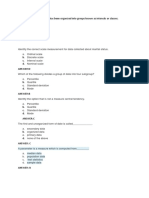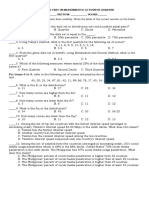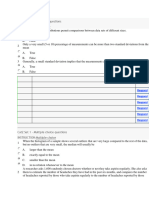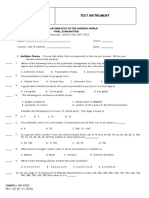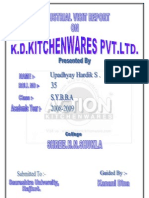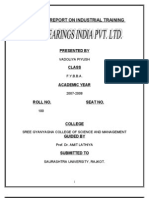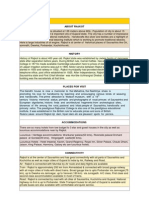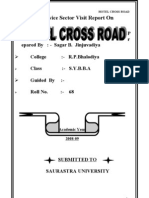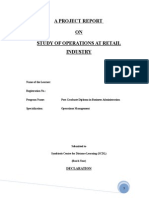Descriptive Statistics Prince
Descriptive Statistics Prince
Uploaded by
pRiNcE DuDhAtRaCopyright:
Available Formats
Descriptive Statistics Prince
Descriptive Statistics Prince
Uploaded by
pRiNcE DuDhAtRaCopyright
Available Formats
Share this document
Did you find this document useful?
Is this content inappropriate?
Copyright:
Available Formats
Descriptive Statistics Prince
Descriptive Statistics Prince
Uploaded by
pRiNcE DuDhAtRaCopyright:
Available Formats
CHAPTER THREE Descriptive Statistics
C 1. Statistical measures used to yield information about the middle of a group of numbers are called _______. A. averages B. measures of variability C. measures of central tendency D. Z scores 2. Which of the following is NOT a measure of central tendency? A. mean B. median C. variance D. mode
E Term
C E Term
73
70
Test Bank A 3. The most frequently occurring value in a set of data is called the _______. E Term A. mode B. mean C. median D. coefficient of variation 4. Which of the following is an appropriate measure of central tendency for nominal data? A. mode B. mean C. median D. coefficient of variation 5. Which of the following is an appropriate measure of central tendency for ordinal data? A. standard deviation B. mean C. median D. coefficient of variation 6. The lowest appropriate level of measurement for the mean is _________. A. nominal B. ordinal C. interval D. ratio 7. The lowest appropriate level of measurement for the median is _________. A. nominal B. ordinal C. interval D. ratio 8. The lowest appropriate level of measurement for the mode is _________. A. nominal B. ordinal C. interval D. ratio
E Term
E Term
C E Term
B E Term
A E Term
C E Term
9.
Chapter 3: Descriptive Statistics The middle value in an ordered array of numbers is called the _______. A. mode B. mean C. median D. coefficient of variation Another term for average is _______. A. mode B. mean C. median D. variance The Greek letter usually refers to the _______. A. population standard deviation B. sample variance C. population mean D. sample mean The Greek letter usually refers to the _________. A. population standard deviation B. sample variance C. population mean D. sample mean The notation X usually refers to the _______________. A. population standard deviation B. sample variance C. population mean D. sample mean The notation s2 usually refers to the _______________. A. population standard deviation B. sample variance C. population mean D. sample mean
71
10.
E Term
11.
E Term
12.
E Term
13.
E Term
14.
E Term
72
Test Bank D 15. Which of the following is NOT a commonly used measure of variability? M Term A. variance B. standard deviation C. mean absolute deviation D. average deviation The sum of deviations about the arithmetic mean is always equal to _______. A. zero B. the variance C. the mean absolute deviation D. the standard deviation The average of the squared deviations from the arithmetic mean is called the _______. A. standard deviation B. mean absolute deviation C. variance D. coefficient of variation The sample variance is found by taking the square root of _______. A. the sample mean B. the sample variance C. the coefficient of variation D. the mean absolute deviation The lowest appropriate level of measurement for standard deviation is _________. A. nominal B. ordinal C. interval D. ratio The lowest appropriate level of measurement for the Interquartile Range is _________. A. nominal B. ordinal C. interval D. ratio
16.
E Term
17.
M Term
18.
E Term
19.
E Term
20.
E Term
Chapter 3: Descriptive Statistics
73
74
Test Bank D 21. The number of standard deviations that a value (X) is above or below the mean is the _________________. M Term A. B. C. D. absolute deviation coefficient of variation interquartile range Z score
22.
If the mean of a distribution is greater than the median, then the distribution is ______. A. B. C. D. not skewed symmetrical about its mean skewed to the left skewed to the right
M Term
23.
If the median of a distribution is greater than mean, then the distribution is _________. A. B. C. D. not skewed symmetrical about its mean skewed to the left skewed to the right
M Term
24.
The interquartile range is _____________. A. B. C. D. the largest value minus the least value the ratio of the mean to the standard deviation negative if the distribution is skewed to the left Q3 - Q1
E Term
25.
The five numbers used to construct a box and whisker plot are _______. A. B. C. D. the mean, standard deviation, Q1, Q3, and the coefficient of variation Q1, Q2, Q3, the least value of X, and the largest value of X the mean, standard deviation, least value of X, largest value of X, and Q2 the coefficient of variation, IQR, mean, Q2, and mean absolute deviation
M Term
26.
Chapter 3: Descriptive Statistics Which of the following is a measure of relative dispersion? A. B. C. D. standard deviation interquartile range mean absolute deviation coefficient of dispersion
75
M Term
27.
The empirical rule says that approximately what percentage of the values would be within 2 standard deviations of the mean in a bell shaped set of data? A. 95% B. 68% C. 50% D. almost all The empirical rule says that approximately what percentage of the values would be within 1 standard deviation of the mean in a bell shaped set of data? A. 95% B. 68% C. 50% D. almost all Chebyshev's Theorem says that how many values will be within 2 standard deviations of the mean? A. at least 75% B. at least 68% C. at least 95% D. at least 89%
M Term
28.
M Term
29.
H Calc
30.
Chebyshev's Theorem says that the number of values within 3 standard deviations of the mean will be _______. A. at least 75% B. at least 68% C. at least 95% D. at least 89%
M Calc
76
Test Bank B 31. A statistics student made the following grades on 5 tests: 84, 78, 88, 78, and 72. What is the mean grade? M Calc A. 78 B. 80 C. 72 D. 84 32. A statistics student made the following grades on 5 tests: 84, 78, 88, 72, and 72. What is the median grade? A. 88 B. 72 C. 78 D. 80 33. A statistics student made the following grades on 5 tests: 84, 78, 88, 78, and 82. What is the mode? A. 78 B. 80 C. 88 D. 84 34. A commuter travels many miles to work each morning. She has timed this trip 5 times during the last month. The time (in minutes) required to make this trip was 34, 39, 41, 35, and 41. The mean time required for this trip was _______. A. B. C. D. 35. 35 41 37.5 38
M Calc
E Calc
M Calc
A commuter travels many miles to work each morning. She has timed this trip 5 times during the last month. The time (in minutes) required to make this trip was 34, 39, 41, 35, and 41. The median time required for this trip was _______. A. B. C. D. 39 41 37.5 38
M Calc
36.
A commuter travels many miles to work each morning. She has timed this trip 5
Chapter 3: Descriptive Statistics 77 times during the last month. The time (in minutes) required to make this trip was 34, 39, 41, 35, and 41. The modal time required for this trip was _______. E Calc A. B. C. D. 37. 39 41 37.5 38
A commuter travels many miles to work each morning. She has timed this trip 5 times during the last month. The time (in minutes) required to make this trip was 44, 39, 41, 35, and 41. The mean time required for this trip was 40 minutes. What is the variance for this sample data? A. B. C. D. 8.8 11 0 3
H Calc
38.
A commuter travels many miles to work each morning. She has timed this trip 5 times during the last month. The time (in minutes) required to make this trip was 44, 39, 41, 35, and 41. The mean time required for this trip was 40 minutes. What is the standard deviation for this sample data? A. B. C. D. 3.32 2.97 1.73 11
H Calc
39.
A commuter travels many miles to work each morning. She has timed this trip 5 times during the last month. The time (in minutes) required to make this trip was 44, 39, 41, 35, and 41. The mean time required for this trip was 40 minutes. What is the mean absolute deviation for this sample data? A. B. C. D. 0 12 3 2.4
H Calc
78
Test Bank D 40. Abel Alonzo, Director of Human Resources, is exploring employee absenteeism at the Batesville Bottling during the last operating year. A sample of six personnel records produced the following data: 0, 2, 4, 7, 2, 9. The mean number absences per employee is ____________. M BCalc A. B. C. D. 3 2 5.5 4
41.
Abel Alonzo, Director of Human Resources, is exploring employee absenteeism at the Batesville Bottling during the last operating year. A sample of six personnel records produced the following data: 0, 2, 4, 7, 2, 9. The modal number absences per employee is ____________. A. B. C. D. 3 2 5.5 4
E BCalc
42.
Abel Alonzo, Director of Human Resources, is exploring employee absenteeism at the Batesville Bottling during the last operating year. A sample of six personnel records produced the following data: 0, 2, 4, 7, 2, 9. The median number absences per employee is ____________. A. B. C. D. 3 2 5.5 4
M BCalc
43.
Abel Alonzo, Director of Human Resources, is exploring employee absenteeism at the Batesville Bottling during the last operating year. A sample of six personnel records produced the following data: 0, 2, 4, 7, 2, 9. The variance of the number absences per employee is ____________. A. B. C. D. 11.6 9.67 3.41 3.11
H BCalc
44.
Chapter 3: Descriptive Statistics 79 Abel Alonzo, Director of Human Resources, is exploring employee absenteeism at the Batesville Bottling during the last operating year. A sample of six personnel records produced the following data: 0, 2, 4, 7, 2, 9. The standard deviation of the number absences per employee is ____________. A. B. C. D. 11.6 9.67 3.41 3.11
H BCalc
45.
The mean life of a particular brand of light bulb is 1000 hours and the standard deviation is 50 hours. It can be concluded that at least 75% of the bulbs will last between _______. A. B. C. D. 900 and 1100 hours 950 and 1050 hours 850 and 1150 hours 800 and 1200 hours
H BCalc
46.
The mean life of a particular brand of light bulb is 1000 hours and the standard deviation is 50 hours. It can be concluded that at least 89% of the bulbs will last between _______. A. B. C. D. 900 and 1100 hours 950 and 1050 hours 850 and 1150 hours 800 and 1200 hours
H BCalc
47.
The mean life of a particular brand of light bulb is 1000 hours and the standard deviation is 50 hours. Tests show that the life of the bulb is approximately normally distributed. It can be concluded that approximately 68% of the bulbs will last between _______. A. B. C. D. 900 and 1100 hours 950 and 1050 hours 850 and 1150 hours 800 and 1200 hours
M Calc
80
Test Bank A 48. Jessica Salas, president of Salas Products, is reviewing the warranty policy for her company's new model of automobile batteries. Life tests performed on a sample of 100 batteries indicated: (1) an average life of 75 months, (2) a standard deviation of 5 months, and (3) battery life is approximately normally distributed. Approximately 68% of the batteries will last between ________________. M BCalc A. B. C. D. 70 and 80 months 60 and 90 months 65 and 85 months 55 and 95 months
49.
Jessica Salas, president of Salas Products, is reviewing the warranty policy for her company's new model of automobile batteries. Life tests performed on a sample of 100 batteries indicated: (1) an average life of 75 months, (2) a standard deviation of 5 months, and (3) battery life is approximately normally distributed. Approximately 95% of the batteries will last between ________________. A. B. C. D. 70 and 80 months 60 and 90 months 65 and 85 months 55 and 95 months
M BCalc
50.
Jessica Salas, president of Salas Products, is reviewing the warranty policy for her company's new model of automobile batteries. Life tests performed on a sample of 100 batteries indicated: (1) an average life of 75 months, (2) a standard deviation of 5 months, and (3) battery life is approximately normally distributed. Approximately 99% of the batteries will last between ________________. A. B. C. D. 70 and 80 months 60 and 90 months 65 and 85 months 55 and 95 months
M BCalc
51.
Jessica Salas, president of Salas Products, is reviewing the warranty policy for her company's new model of automobile batteries. Life tests performed on a sample of 100 batteries indicated: (1) an average life of 75 months, (2) a standard deviation of 5 months, and (3) battery life is approximately normally distributed. What percentage of the batteries will fail within the first 65 months of use? A. B. C. D. 0.5% 1% 2.5% 5%
H BCalc
Chapter 3: Descriptive Statistics B 52.
81
The average starting salary for graduates at a university is $25,000 with a standard deviation of $2,000. If a histogram of the data shows the it takes on a mound shape, the empirical rule says that approximately 95% of the graduates would have a starting salary between _______. A. B. C. D. 23,000 and 27,000 21,000 and 29,000 19,000 and 31,000 24,000 and 26,000
M BCalc
53.
The average starting salary for graduates at a university is $25,000 with a standard deviation of $2,000. If a histogram of the data shows the it takes on a mound shape, the empirical rule says that approximately 68% of the graduates would have a starting salary between _______. A. B. C. D. 23,000 and 27,000 21,000 and 29,000 19,000 and 31,000 24,000 and 26,000
M BCalc
54.
The average starting salary for graduates at a university is $25,000 with a standard deviation of $2,000. A histogram of the data shows the shape to be very erratic so Chebyshev's Theorem should be used. How many of the graduates would have a starting salary between 21,000 and 29,000? A. B. C. D. at least 75% at least 89% at least 68% at least 95%
H BCalc
55.
The average starting salary for graduates at a university is $25,000 with a standard deviation of $2,000. A histogram of the data shows the shape to be very erratic so Chebyshev's Theorem should be used. How many of the graduates would have a starting salary between 19,000 and 31,000? A. B. C. D. at least 75% at least 89% at least 68% at least 95%
H BCalc
82
Test Bank B 56. The ages of students in a class have been put into the frequency distribution below. Age Number of Students 18 3 19 5 20 28 21 4 What is the average age of these students? M Calc A. B. C. D. 57. 19.50 19.85 20.00 28.00
The ages of students in a class have been put into the frequency distribution below. Age Number of Students 18 3 19 5 20 28 21 4 What is the standard deviation for this (population) set of data? A. B. C. D. 0.494 0.703 1.12 1.25
H Calc
58.
The ages of students in a class have been put into the frequency distribution below. Age Number of Students 18 3 19 5 20 28 21 4 What is the median age of these students? A. B. C. D. 18 19 19.5 20
M Calc
59.
The ages of students in a class have been put into the frequency distribution
Chapter 3: Descriptive Statistics below. Age Number of Students 18 3 19 5 20 28 21 4 What is the modal age of these students? E Calc A. B. C. D. 60. 18 19 20 21
83
The mean, median, and mode for the following set of data are all the same value (20). Data: 18, 19, 20, 20, 21, 22. If the highest number were changed from 22 to 322, which of the following would be most affected? A. B. C. D. mean median mode sample size
M App
61.
In its Industry Norms and Key Business Ratios, Dun & Bradstreet reported that Q1, Q2, and Q3 for 577 motorcycle dealers' current ratios were 1.3, 1.6 and 2.9, respectively. From this we can conclude that __________________. A. B. C. D. 68% of these dealers had current ratios between 1.3 and 2.9 95% of these dealers had current ratios between 1.3 and 2.9 50% of these dealers had current ratios between 1.3 and 2.9 75% of these dealers had current ratios between 1.3 and 2.9
M BApp
84
Test Bank C 62. An instructor is evaluating the performance of students on a test. He records the number of points that each student missed and created a frequency distribution. This is provided below: Points missed Number of students 0-under 10 2 10-under 20 4 20-under 30 10 30-under 40 8 40-under 50 6 What is the mean number of points missed? H Calc A. B. C. D. 63. 20 25 29 30
An instructor is evaluating the performance of students on a test. He records the number of points that each student missed and created a frequency distribution. This is provided below: Points missed Number of students 0-under 10 2 10-under 20 4 20-under 30 10 30-under 40 8 40-under 50 6 What is the variance for this population? A. B. C. D. 11.43 135.17 130.67 200
H Calc
64.
In its Industry Norms and Key Business Ratios, Dun & Bradstreet reported that Q1, Q2, and Q3 for 577 motorcycle dealers' current ratios were 1.3, 1.6 and 2.9, respectively. From this we can conclude that __________________. A. B. C. D. 68% of these dealers had current ratios of 1.6 or less 95% of these dealers had current ratios of 2.9 or less 50% of these dealers had current ratios of 2.9 or more 75% of these dealers had current ratios of 1.3 or more
M BApp
65.
An instructor is evaluating the performance of students on a test. He records the number of points that each student missed and created a frequency distribution.
Chapter 3: Descriptive Statistics This is provided below: Points missed Number of students 0-under 10 2 10-under 20 4 20-under 30 10 30-under 40 8 40-under 50 6 What is the standard deviation for this population? H Calc A. B. C. D. 66. 11.43 14.14 11.63 135.17
85
An instructor is evaluating the performance of students on a test. He records the number of points that each student missed and created a frequency distribution. This is provided below: Points missed Number of students 0-under 10 2 10-under 20 4 20-under 30 10 30-under 40 8 40-under 50 6 If this is considered a sample, what is the standard deviation? A. B. C. D. 11.43 14.14 11.63 135.17
H Calc
67.
Which of the following is always true? A. B. C. D. the median is always one-half of the mean the mode is always greater than the mean the mean is always equal to the median the standard deviation is always the square root of the variance
E Term
86
Test Bank A 68. Pinky Bauer, Chief Financial Officer of Harrison Haulers, Inc., suspects irregularities in the payroll system, and orders an inspection of "each and every payroll voucher issued since January 1, 1993." Each payroll voucher was inspected and the following frequency distribution was compiled. Errors Per Voucher Number of Vouchers 0-under 2 500 2-under 4 400 4-under 6 300 6-under 8 200 8-under 10 100 The mean number of errors per voucher is __________. H BCalc A. B. C. D. 3.67 5 750 300
69.
Pinky Bauer, Chief Financial Officer of Harrison Haulers, Inc., suspects irregularities in the payroll system, and orders an inspection of "each and every payroll voucher issued since January 1, 1993." Each payroll voucher was inspected and the following frequency distribution was compiled. Errors Per Voucher Number of Vouchers 0-under 2 500 2-under 4 400 4-under 6 300 6-under 8 200 8-under 10 100 The distribution of errors per voucher is __________. A. B. C. D. symmetrical with respect to its mean skewed to the right not skewed negatively skewed
M BApp
70.
A sales manager has sampled past sales records to determine how many refrigerators are sold each day. Daily records for a sample of 10 days have been selected. The sales on these days are: 0, 4, 4, 2, 1, 3, 4, 5, 2, 7. What is the mean daily sales? A. B. C. D. 2 4 3.2 10
M BCalc
Chapter 3: Descriptive Statistics C 71.
87
A sales manager has sampled past sales records to determine how many refrigerators are sold each day. Daily records for a sample of 10 days have been selected. The sales on these days are: 0, 4, 3, 2, 1, 3, 5, 5, 2, 5. What is the median daily sales? A. B. C. D. 3.5 2 3 4
M BCalc
72.
A sales manager has sampled past sales records to determine how many refrigerators are sold each day. Daily records for a sample of 10 days have been selected. The sales on these days are: 0, 4, 4, 2, 1, 3, 4, 5, 2, 7. The mode of data set is ______. A. 3.5 B. 2 C. 3 D. 4 A sales manager has sampled past sales records to determine how many televisions are sold each day. Daily records for a sample of 5 days have been selected. The sales on these days are: 2, 4, 5, 2, 7. What is the mean for this set of data? A. B. C. D. 2 4 5 4.5
E BCalc
73.
E BCalc
74.
A sales manager has sampled past sales records to determine how many televisions are sold each day. Daily records for a sample of 5 days have been selected. The sales on these days are: 2, 4, 5, 2, 7. What is the mode for this set of data? A. B. C. D. 2 4 5 4.5
E BCalc
88
Test Bank A 75. In its Industry Norms and Key Business Ratios, Dun & Bradstreet reported that Q1, Q2, and Q3 for 577 motorcycle dealers' current ratios were 1.3, 1.6 and 2.9, respectively. From this we can conclude that __________________. E BApp A. B. C. D. 50% of these dealers had current ratios of 1.6 or less 68% of these dealers had current ratios of 1.3 or less 50% of these dealers had current ratios of 2.9 or more 95% of these dealers had current ratios of 1.3 or more
76.
A sales manager has sampled past sales records to determine how many televisions are sold each day. Daily records for a sample of 5 days have been selected. The sales on these days are: 2, 4, 5, 2, 7. What is the standard deviation for this set of sample data? A. B. C. D. 2 0 2.12 4.5
M BCalc
77.
A sales manager has sampled past sales records to determine how many televisions are sold each day. Daily records for a sample of 5 days have been selected. The sales on these days are: 2, 4, 5, 2, 7. What is the variance for this set of sample data? A. B. C. D. 4 4.5 2 0
M BCalc
78.
A sales manager has sampled past sales records to determine how many televisions are sold each day. Daily records for a sample of 5 days have been selected. The sales on these days are: 2, 4, 5, 2, 7. What is the median for this set of data? A. B. C. D. 2 4 5 4.5
E BCalc
79.
Chapter 3: Descriptive Statistics 89 A sales manager has sampled past sales records to determine how many televisions are sold each day. Daily records for a sample of 5 days have been selected. The sales on these days are: 2, 4, 5, 2, 7. What is the mean absolute deviation for this set of data? A. B. C. D. 0 2 1.6 4
M BCalc
80.
Consider the following 3 numbers: 10, 20, 30. In calculating measures of central tendency and variability for this set of data, which of the following is true? A. you can calculate the mean only if you know if this is a sample or a population B. you can calculate the median only if you know if this is a sample or a population C. you can calculate the mode only if you know if this is a sample or a population D. you can calculate the variance only if you know if this is a sample or a population
M App
81.
Liz Chapa manages a portfolio of 250 common stocks. Her staff compiled the following performance statistics for two new stocks. Rate of Return Stock Standard Deviation Salas Products, Inc. 5% Hot Boards, Inc. 5% The coefficient of variation for Salas Products, Inc. is __________. A. B. C. D. 300% 100% 33% 5%
E BCalc
90
Test Bank B 82. The following box and whisker plot was constructed for the age of accounts receivable.
The box and whisker plot reveals that the accounts receivable ages are _______. E BApp A. B. C. D. skewed to the left skewed to the right not skewed normally distributed
83.
The following box and whisker plot was constructed for the age of accounts receivable.
The box and whisker plot reveals that the accounts receivable ages are _______. E BApp A. B. C. D. skewed to the left skewed to the right not skewed normally distributed
84.
The following frequency distribution was constructed for the age of accounts receivable.
The frequency distribution reveals that the accounts receivable ages are _______. E BApp A. B. C. D. skewed to the left skewed to the right not skewed normally distributed
85.
The following frequency distribution was constructed for the age of accounts receivable.
Chapter 3: Descriptive Statistics
91
The frequency distribution reveals that the accounts receivable ages are _______. E BApp A. B. C. D. skewed to the left skewed to the right not skewed normally distributed
86.
Liz Chapa manages a portfolio of 250 common stocks. Her staff compiled the following performance statistics for two new stocks. Rate of Return Stock Standard Deviation Salas Products, Inc. 5% Hot Boards, Inc. 5% The coefficient of variation for Salas Products, Inc. is __________. A. B. C. D. equal to the coefficient of variation for Hot Boards greater than the coefficient of variation for Hot Boards less than the coefficient of variation for Hot Boards 25%
M BCalc
87.
David Desreumaux, VP of Human Resources of American First Banks (AFB), is reviewing the employee training programs of AFB banks. His staff compiled the following table of regional statistics on teller training hours. Southeast Region Southwest Region Mean 20 28 Median 20 20 Mode 20 21 Standard Deviation 5 7 What can David conclude from these statistics? A. B. C. D. the Southeast distribution is skewed to the left the Southeast distribution is skewed to the right the Southwest distribution is skewed to the left the Southwest distribution is skewed to the right
M BApp
92
Test Bank A 88. David Desreumaux, VP of Human Resources of American First Banks (AFB), is reviewing the employee training programs of AFB banks. His staff compiled the following table of regional statistics on teller training hours. Southeast Region Southwest Region Mean 20 28 Median 20 20 Mode 20 21 Standard Deviation 5 7 What can David conclude from these statistics? M BApp A. B. C. D. the Southwest distribution has the greater dispersion the Southwest distribution is skewed to the left the Southeast distribution has the greater dispersion the Southeast distribution is skewed to the left
89.
David Desreumaux, VP of Human Resources of American First Banks (AFB), is reviewing the employee training programs of AFB banks. His staff compiled the following table of regional statistics on teller training hours. Southeast Region Southwest Region Mean 20 28 Median 20 20 Mode 20 21 Standard Deviation 5 7 What can David conclude from these statistics? A. B. C. D. the Southwest distribution has the greater relative dispersion the Southwest distribution is skewed to the left the Southeast distribution has the greater relative dispersion the Southeast distribution is not skewed
M BApp
90.
Chapter 3: Descriptive Statistics 93 Manuel Banales, Marketing Director of Plano Power Plants, Inc.s Electrical Division, is leading a study to assess the relative importance of product features. Two items on a survey questionnaire distributed to 100 of Planos customers asked them to rate the importance of ease of maintenance and efficiency of operation on a scale of 1 to 10 (with 1 meaning not important and 10 meaning highly important). His staff assembled the following statistics on these two items. Ease of Maintenance Efficiency of Operation Mean 7.5 6.0 Median 8.5 5.5 Mode 9.0 4.5 Standard Deviation 1.5 2.5 What can Manuel conclude from these statistics? A. B. C. D. the Ease of Maintenance distribution is skewed to the right the Ease of Maintenance distribution is not skewed the Efficiency of Operation distribution is skewed to the left the Efficiency of Operation distribution is positively skewed
M BApp
91.
Manuel Banales, Marketing Director of Plano Power Plants, Inc.s Electrical Division, is leading a study to assess the relative importance of product features. Two items on a survey questionnaire distributed to 100 of Planos customers asked them to rate the importance of ease of maintenance and efficiency of operation on a scale of 1 to 10 (with 1 meaning not important and 10 meaning highly important). His staff assembled the following statistics on these two items. Ease of Maintenance Efficiency of Operation Mean 7.5 6.0 Median 8.5 5.5 Mode 9.0 4.5 Standard Deviation 1.5 2.5 What can Manuel conclude from these statistics? A. B. C. D. the Ease of Maintenance distribution has more relative dispersion the Ease of Maintenance distribution has less dispersion the Efficiency of Operation distribution is skewed to the left the Efficiency of Operation distribution has less dispersion
M BApp
94
Test Bank A 92. Manuel Banales, Marketing Director of Plano Power Plants, Inc.s Electrical Division, is leading a study to assess the relative importance of product features. Two items on a survey questionnaire distributed to 100 of Planos customers asked them to rate the importance of ease of maintenance and efficiency of operation on a scale of 1 to 10 (with 1 meaning not important and 10 meaning highly important). His staff assembled the following statistics on these two items. Ease of Maintenance Efficiency of Operation Mean 7.5 6.0 Median 8.5 5.5 Mode 9.0 4.5 Standard Deviation 1.5 2.5 What can Manuel conclude from these statistics? M BApp A. B. C. D. Ease of Maintenance is more important than Efficiency of Operation Efficiency of Operation is more important than Ease of Maintenance Efficiency of Operation and Ease of Maintenance are equally important the Efficiency of Operation distribution has less dispersion
93.
In its Industry Norms and Key Business Ratios, Dun & Bradstreet reported that Q1, Q2, and Q3 for 2,037 gasoline service stations' sales to inventory ratios were 20.8, 33.4, and 53.8, respectively. From this we can conclude that ____________. A. B. C. D. 68% of these service stations had sales to inventory ratios of 20.8 or less 50% of these service stations had sales to inventory ratios of 33.4 or less 50% of these service stations had sales to inventory ratios of 53.8 or more 95% of these service stations had sales to inventory ratios of 20.8 or more
E BApp
94.
Albert Abbasi, VP of Operations at Ingleside International Bank, is evaluating the service level provided to walk-in customers. Accordingly, his staff prepared the following distribution of waiting time for walk-in customers. Waiting Time Number of Customers (in minutes) 0-under 2 60 2-under 4 30 4-under 6 10 The mean waiting time for this sample of walk-in customers is _________. A. B. C. D. 2 minutes 66.67 minutes 33.33 minutes 3 minutes
H BCalc
Chapter 3: Descriptive Statistics B 95.
95
Albert Abbasi, VP of Operations at Ingleside International Bank, is evaluating the service level provided to walk-in customers. Accordingly, his staff prepared the following distribution of waiting time for walk-in customers. Waiting Time Number of Customers (in minutes) 0-under 2 60 2-under 4 30 4-under 6 10 The standard deviation of waiting time for this sample of walk-in customers is ______. A. B. C. D. 2 minutes 1.35 minutes 1.82 minutes 1.80 minutes
H BCalc
96.
David Desreumaux, VP of Human Resources of American First Banks (AFB), is reviewing the employee training programs of AFB banks. His staff reports several statistics for teller training hours. The mean is 20 hours, the standard deviation is 5 hours, the median is 15 hours, and mode is 10 hours. The Pearsonian coefficient of skewness for teller training hours is __________. A. B. C. D. 6 1 3 4
M BCalc
97.
The following box and whisker plot was constructed for the age of accounts receivable.
The box and whisker plot reveals that the accounts receivable ages are _______. E BApp A. B. C. D. skewed to the left skewed to the right not skewed normally distributed
96
Test Bank C 98. The following frequency distribution was constructed for the age of accounts receivable.
The frequency distribution reveals that the accounts receivable ages are _______. E BApp A. B. C. D. skewed to the left skewed to the right not skewed positively skewed
99.
Which Excel function returns the second quartile? A. B. C. D. median() mode() max() quart2()
E Term
B 100. M Term
Which Excel function returns the population standard deviation? A. B. C. D. pstdev() stdevp() stdev() stdevpop()
C 101. M Term
Which Excel function returns the sample standard deviation? A. B. C. D. sstdev() stdevs() stdev() stdevsample()
D 102. M Term
Which Excel function returns the arithmetic mean? A. B. C. D. amean() meana() mean() average()
103.
Chapter 3: Descriptive Statistics 97 Albert Abbasi, VP of Operations at Ingleside International Bank (IIB), is evaluating the service level provided to walk-in customers. Accordingly, his staff prepared the following distribution of waiting time for walk-in customers. Waiting Time Number of Customers (in minutes) 0-under 2 120 2-under 4 40 4-under 6 25 6-under 8 10 8-under 10 5 In a recent survey, 70% of the walk-in customers indicated that waiting four minutes (or more) was unacceptable. Presently, IIB has no direct competitors, but a competing bank is under construction across the street. Discuss the managerial and business implications of this situation. What alternatives should Albert consider? What graphic depiction should he choose for his presentation to the banks board of directors?
M BApp
_________________________________________________________________ _________________________________________________________________ _________________________________________________________________ _________________________________________________________________ _________________________________________________________________ _________________________________________________________________ _________________________________________________________________ _________________________________________________________________ _________________________________________________________________ _________________________________________________________________
98
Test Bank 104. Angelina Arnott, Director of National Industrial Sales, is concerned by a deteriorating sales trend. Specifically, the number of customers is stable at 1,500, but they are purchasing less each year. She orders her staff to search for causes of the downward trend by surveying all 1,500 industrial customers. One question on the survey asked the customers to rate Merchandise is delivered on time on a scale of 1 to 5, with 1 meaning never and 5 meaning always. Merchandise Delivered On Time 1 2 3 4 5 No Response Number of Customers 100 200 300 700 100 100
Discuss the managerial and business implications of Angelinas situation. Identify some possible causes of the trend. What corrective actions are available for each cause? What graphic depiction(s) should she choose for her report to the VP of Marketing? M BApp _________________________________________________________________ _________________________________________________________________ _________________________________________________________________ _________________________________________________________________ _________________________________________________________________ _________________________________________________________________ _________________________________________________________________ _________________________________________________________________ _________________________________________________________________ _________________________________________________________________
105.
Chapter 3: Descriptive Statistics 99 Annualized rates of return were calculated from closing prices of Caterpillar (CAT) and General Mills (GIS) common stock. Descriptive statistics of these rates of return presented in the following table.
CAT GIS Mean 0.233621705 0.139744793 Standard Error 0.162775427 0.097267227 Median 0.194367839 0.122108626 Mode #N/A 0 Standard Deviation 1.091930758 0.652488394 Sample Variance 1.19231278 0.425741105 Kurtosis 6.478114897 -0.59713571 Skewness 1.647492156 0.058132445 Range 6.669350226 2.710777183 Minimum -1.770866463 -1.256246317 Maximum 4.898483762 1.454530866 Sum 10.51297674 6.288515695 Count 45 45
Describe what these descriptive statistics reveal about the market performance of these two stocks. M BApp
100
Test Bank 106. Descriptive statistics of daily sales ($'s) were calculated for two Bob's Quick Shops -- the Southside store, and the Midcity store. Southside Mean 5025.622 Standard Error 118.306 Median 5110.73 Mode #N/A Standard Deviation 916.394 Sample Variance 839778 Kurtosis -0.64387 Skewness -0.05517 Range 3949.172 Minimum 3133.362 Maximum 7082.534 Sum 301537.3 Count 60 Midcity 2733.333 249.1417 2000 1000 1929.843 3724294 -0.49322 0.860968 6000 1000 7000 164000 60
Describe what these descriptivie statistics indicate about daily sales at these two stores. M BApp
C 107.
Chapter 3: Descriptive Statistics According to the following graphic, X and Y are _________.
130 120 110 100 90 80 70 1400 1600 1800 X 2000 2200 2400 Y
101
E BApp
A. B. C. D.
strong negative correlation virtually no correlation strong positive correlation moderate negative correlation
B 108.
According to the following graphic, X and Y are _________.
130 120 110 100 90 80 70 0 5 10 15 X 20 25 30 Y
E BApp
A. B. C. D.
strong negative correlation virtually no correlation strong positive correlation moderate negative correlation
You might also like
- Final Examination in Statistics and ProbabilityDocument2 pagesFinal Examination in Statistics and ProbabilityMagz Magan100% (15)
- Practical Engineering, Process, and Reliability StatisticsFrom EverandPractical Engineering, Process, and Reliability StatisticsNo ratings yet
- NAT REVIEWER Statistics ProbabilityDocument8 pagesNAT REVIEWER Statistics ProbabilityMTCDP FILESNo ratings yet
- Multiple Choice Questions Business StatisticsDocument60 pagesMultiple Choice Questions Business StatisticsChinmay Sirasiya (che3kuu)No ratings yet
- QT 600Document20 pagesQT 600Innocent Ramaboka0% (1)
- CH 03Document40 pagesCH 03AlexanderNo ratings yet
- ch03Document40 pagesch03aashir.aftab01No ratings yet
- CH 03Document32 pagesCH 03Tanya YablonskayaNo ratings yet
- Descriptive Statistics QuestionsDocument33 pagesDescriptive Statistics QuestionsPARUL SINGH MBA 2019-21 (Delhi)No ratings yet
- Geo Ma HG Basic Statistics Self TestDocument9 pagesGeo Ma HG Basic Statistics Self TestDANANo ratings yet
- Beniga Ma 102 Pre-Test ExamDocument6 pagesBeniga Ma 102 Pre-Test ExamRowena Beniga0% (1)
- Final Exam in Statistics and Probability Grade 11Document21 pagesFinal Exam in Statistics and Probability Grade 11Celine Mary DamianNo ratings yet
- Quarter 3 - Summative Test STATDocument9 pagesQuarter 3 - Summative Test STATAnne FrondaNo ratings yet
- Math Q4Document4 pagesMath Q4RUBY ROSE BALLATONGNo ratings yet
- Stat ExamDocument2 pagesStat ExamKelvin C. Grajo100% (1)
- Midtermtest 158-1Document5 pagesMidtermtest 158-1minhchauNo ratings yet
- Midterm in GE 103Document9 pagesMidterm in GE 103Josaril Mark Francisco DanielNo ratings yet
- Preliminary Examination in Statistics & ProbabilityDocument3 pagesPreliminary Examination in Statistics & Probabilitychristian enriquezNo ratings yet
- Chap003 Describing Data Numerical MeasuresDocument79 pagesChap003 Describing Data Numerical Measuresragcajun100% (2)
- Mock Exam Midterm Statistics IDocument24 pagesMock Exam Midterm Statistics IDelia MunteanuNo ratings yet
- Statistics and Probability 4th QEDocument5 pagesStatistics and Probability 4th QEDaniel BerdidaNo ratings yet
- Stat and Prob-Thirrd QADocument4 pagesStat and Prob-Thirrd QASharlyn BalgoaNo ratings yet
- Stats Q3 Unit Test With AnswerDocument3 pagesStats Q3 Unit Test With Answerraulbucao28No ratings yet
- Assignment Quiz On Statistical IntervalsDocument4 pagesAssignment Quiz On Statistical IntervalsblechiecaliNo ratings yet
- Exercises - Ge 4 Mathematics in The Modern WorldDocument7 pagesExercises - Ge 4 Mathematics in The Modern WorldMervin Jason Nicavera BonsolNo ratings yet
- Stat 315-704 - Exam 1 Wednesday June 10, 2009 Instructor: Ali ShojaieDocument11 pagesStat 315-704 - Exam 1 Wednesday June 10, 2009 Instructor: Ali ShojaieChinmay MohapatraNo ratings yet
- CA51018 Departmentals Quiz 1, 2, 3, - 4Document38 pagesCA51018 Departmentals Quiz 1, 2, 3, - 4artemisNo ratings yet
- Business Research MethodsDocument15 pagesBusiness Research MethodsDisha SharmaNo ratings yet
- Business StrategyDocument17 pagesBusiness Strategysureshbeliver005No ratings yet
- Exercises c3Document7 pagesExercises c3ye yeNo ratings yet
- Applied Statistics From Bivariate Through Multivariate Techniques 2nd Edition Warner Test BankDocument6 pagesApplied Statistics From Bivariate Through Multivariate Techniques 2nd Edition Warner Test BankGregWilsonjpdks100% (1)
- Maths AptDocument11 pagesMaths Aptsebsibe thomasNo ratings yet
- JensenDocument6 pagesJensenJensen BronolaNo ratings yet
- Statistics Quarter 3 Midterms ReviewerDocument6 pagesStatistics Quarter 3 Midterms ReviewerKristoppe SitoyNo ratings yet
- Statistics For The Behavioral Sciences 4th Edition Nolan Test Bank DownloadDocument15 pagesStatistics For The Behavioral Sciences 4th Edition Nolan Test Bank DownloadBarbara Hammett100% (26)
- Statistics Q4-SummativeDocument7 pagesStatistics Q4-Summativeneil ponoyNo ratings yet
- Local Media100839098740108681Document4 pagesLocal Media100839098740108681Majoy AcebesNo ratings yet
- التاسعةDocument12 pagesالتاسعةameerel3tma77No ratings yet
- Multiple ChoiceDocument15 pagesMultiple Choice616398902No ratings yet
- Chapter 3 Study GuideDocument11 pagesChapter 3 Study Guidereema0% (1)
- Cat2 Set 3 - Multiple Choice Questions INSTRUCTION: Multiple ChoiceDocument7 pagesCat2 Set 3 - Multiple Choice Questions INSTRUCTION: Multiple ChoiceerenaNo ratings yet
- Statproba Reviewer 1Document4 pagesStatproba Reviewer 1Aiza mae MontiagodoNo ratings yet
- Stat and Prob - Q3 Week 6 - Mod 6Document26 pagesStat and Prob - Q3 Week 6 - Mod 6JessicaNo ratings yet
- MB0040 MQP Answer KeysDocument19 pagesMB0040 MQP Answer KeysajeetNo ratings yet
- AU5 - Lesson 1 HW - Measures of Center and VariabilityDocument4 pagesAU5 - Lesson 1 HW - Measures of Center and VariabilityKatie VaqueroNo ratings yet
- Midterm StatDocument5 pagesMidterm Statgerona.marquezaNo ratings yet
- 405d - Business StatisticsDocument21 pages405d - Business StatisticsSaurabh AdakNo ratings yet
- Direction: Write The Letter of The Correct Answer On Your Answer SheetDocument3 pagesDirection: Write The Letter of The Correct Answer On Your Answer SheetNeah Neoh NeohnNo ratings yet
- CH 4 Quiz Bank Testing and AssessmentDocument70 pagesCH 4 Quiz Bank Testing and AssessmentJB33% (3)
- Reyes Shaina Ba Psychology 2A Topic 3: Measures of Central Tendency and Variability Multiple ChoiceDocument5 pagesReyes Shaina Ba Psychology 2A Topic 3: Measures of Central Tendency and Variability Multiple ChoiceKean LlorinNo ratings yet
- Lind17e Chapter03 TBDocument11 pagesLind17e Chapter03 TBdockmom4No ratings yet
- Test Instrument: Gecc 103 - Mathematics in The Modern World Final ExaminationDocument6 pagesTest Instrument: Gecc 103 - Mathematics in The Modern World Final ExaminationMark Nathaniel Buccat CalimlimNo ratings yet
- Physical World-Units-Measurements (Physics) Bit BankFrom EverandPhysical World-Units-Measurements (Physics) Bit BankRating: 5 out of 5 stars5/5 (2)
- ACT Math Section and SAT Math Level 2 Subject Test Practice Problems 2013 EditionFrom EverandACT Math Section and SAT Math Level 2 Subject Test Practice Problems 2013 EditionRating: 3 out of 5 stars3/5 (3)
- SAT Math Level 2 Subject Test Practice Problems 2013 EditionFrom EverandSAT Math Level 2 Subject Test Practice Problems 2013 EditionRating: 1 out of 5 stars1/5 (1)
- AP Computer Science Principles: Student-Crafted Practice Tests For ExcellenceFrom EverandAP Computer Science Principles: Student-Crafted Practice Tests For ExcellenceNo ratings yet
- K.D.ketcHENWARES PVT - Ltd. Project Report-Prince DudhatraDocument78 pagesK.D.ketcHENWARES PVT - Ltd. Project Report-Prince DudhatrapRiNcE DuDhAtRaNo ratings yet
- KICH MKT PVT LTD Project Report-Prince DudhatraDocument93 pagesKICH MKT PVT LTD Project Report-Prince DudhatrapRiNcE DuDhAtRa67% (3)
- Interview QuestionDocument2 pagesInterview QuestionpRiNcE DuDhAtRaNo ratings yet
- Kishan Cemenet Bba Mba Project ReportDocument78 pagesKishan Cemenet Bba Mba Project ReportpRiNcE DuDhAtRa50% (2)
- Kadvani Project Report-Prince DudhatraDocument69 pagesKadvani Project Report-Prince DudhatrapRiNcE DuDhAtRa100% (1)
- History of Rajkot Bba Mba Project ReportDocument2 pagesHistory of Rajkot Bba Mba Project ReportpRiNcE DuDhAtRaNo ratings yet
- How To Write A Book ReviewDocument6 pagesHow To Write A Book ReviewpRiNcE DuDhAtRa100% (1)
- Icici BankDocument33 pagesIcici BankpRiNcE DuDhAtRaNo ratings yet
- Hero Agro Project Report-Prince DudhatraDocument76 pagesHero Agro Project Report-Prince DudhatrapRiNcE DuDhAtRaNo ratings yet
- How To Start Ur Business Without MoneyDocument15 pagesHow To Start Ur Business Without MoneypRiNcE DuDhAtRaNo ratings yet
- Gujarat State Financial Corporation-Bba-Mba-Project ReportDocument84 pagesGujarat State Financial Corporation-Bba-Mba-Project ReportpRiNcE DuDhAtRaNo ratings yet
- HOTEL K ROSE Project Report-Prince DudhatraDocument62 pagesHOTEL K ROSE Project Report-Prince DudhatrapRiNcE DuDhAtRaNo ratings yet
- Hotel Cross Road MBA Project Report Prince DudhatraDocument68 pagesHotel Cross Road MBA Project Report Prince DudhatrapRiNcE DuDhAtRaNo ratings yet
- Gravity Project Report-Prince DudhatraDocument29 pagesGravity Project Report-Prince DudhatrapRiNcE DuDhAtRaNo ratings yet
- Granolite Vitrified Tiles Pvt. LTD Project Report-Prince DudhatraDocument59 pagesGranolite Vitrified Tiles Pvt. LTD Project Report-Prince DudhatrapRiNcE DuDhAtRaNo ratings yet
- GOPAL DAIRY PROJECT MBA Project Report Prince DudhatraDocument68 pagesGOPAL DAIRY PROJECT MBA Project Report Prince DudhatrapRiNcE DuDhAtRa86% (7)
- Forge & Forg Project Report-Prince DudhatraDocument87 pagesForge & Forg Project Report-Prince DudhatrapRiNcE DuDhAtRaNo ratings yet
- ECH JAY Industries Project Report-Prince DudhatraDocument119 pagesECH JAY Industries Project Report-Prince DudhatrapRiNcE DuDhAtRa100% (6)
- Chapter 8 - InventoryDocument12 pagesChapter 8 - InventoryAmira QasrinaNo ratings yet
- Universal College of Parañaque: Inventories Related Standards: Pas 2 - InventoriesDocument26 pagesUniversal College of Parañaque: Inventories Related Standards: Pas 2 - InventoriesTeresaNo ratings yet
- A Study On The Effects of Inventory Management On The Performance of The Procurement Function of Sugar Manufacturing CompaniesDocument8 pagesA Study On The Effects of Inventory Management On The Performance of The Procurement Function of Sugar Manufacturing CompaniesRabinarayan MandalNo ratings yet
- SCM Building BlocksDocument22 pagesSCM Building BlocksAashnaNo ratings yet
- 3 - U III WCM InvDocument47 pages3 - U III WCM InvabhishelNo ratings yet
- Conclusion Ca - JitDocument2 pagesConclusion Ca - JitNanditaNo ratings yet
- Operating CycleDocument3 pagesOperating CycleRahul RahatalNo ratings yet
- 10/10 - Rock Excavation Handbook / PlanningDocument11 pages10/10 - Rock Excavation Handbook / PlanningHakan_KURUNo ratings yet
- SIA 4-12 Manual Sales Order Processing SystemsDocument2 pagesSIA 4-12 Manual Sales Order Processing SystemsShela NFNo ratings yet
- Chapter 7 - INVENTORY MANAGEMENTDocument11 pagesChapter 7 - INVENTORY MANAGEMENTLong Đoàn PhiNo ratings yet
- Successfully Navigating The Turbulent Skies of A Large-Scale ERP ImplementationDocument2 pagesSuccessfully Navigating The Turbulent Skies of A Large-Scale ERP ImplementationRizky ShiddiqyNo ratings yet
- Retail Management: A Strategic Approach: Pricing in RetailingDocument29 pagesRetail Management: A Strategic Approach: Pricing in RetailingSumaiyah AlifahNo ratings yet
- MTL Transactions Datamodel DeltaDocument6 pagesMTL Transactions Datamodel Deltaangra11No ratings yet
- Accpac - Guide - Manual For OE User Guide PDFDocument319 pagesAccpac - Guide - Manual For OE User Guide PDFcaplusincNo ratings yet
- Practice Exam 01 312S04Document12 pagesPractice Exam 01 312S04coolankit10No ratings yet
- Study of Operations at Retail IndustryDocument74 pagesStudy of Operations at Retail Industrysameer7986100% (1)
- Chapter 11Document10 pagesChapter 11Coursera2012No ratings yet
- Analisis Laporan KeuanganDocument4 pagesAnalisis Laporan KeuanganStone BreakerNo ratings yet
- Chapter 9 Group PreDocument2 pagesChapter 9 Group Prege geNo ratings yet
- GDPDocument40 pagesGDPSimantoPreeomNo ratings yet
- Practice Quiz 07 - ACTG240 - Q2202122Document11 pagesPractice Quiz 07 - ACTG240 - Q2202122Đinh Ngọc Minh ChâuNo ratings yet
- FICO Integration With Logistics: Process Flows, Accounting, and Valuation SimplifiedDocument36 pagesFICO Integration With Logistics: Process Flows, Accounting, and Valuation SimplifiedHridya PrasadNo ratings yet
- Bin CardDocument13 pagesBin CardAmit Karande100% (1)
- Inventory Management: Learning ObjectivesDocument3 pagesInventory Management: Learning ObjectivesAzyrah Lyren Seguban Ulpindo100% (1)
- Disposal Request FormDocument2 pagesDisposal Request FormNarath ChanNo ratings yet
- Inventories ReviewDocument33 pagesInventories ReviewReginald ValenciaNo ratings yet
- Midterm Cost Accounting and ControlDocument9 pagesMidterm Cost Accounting and ControlMechaella Shella Ningal ApolinarioNo ratings yet
- Lesson 5 HandoutDocument20 pagesLesson 5 HandoutIan De DiosNo ratings yet
- Caf 8 Cma ST PDFDocument656 pagesCaf 8 Cma ST PDFAbdullah DildarNo ratings yet
- Ludowicz Acquired 20 of The Common Shares of Sitar On PDFDocument1 pageLudowicz Acquired 20 of The Common Shares of Sitar On PDFTaimour HassanNo ratings yet




